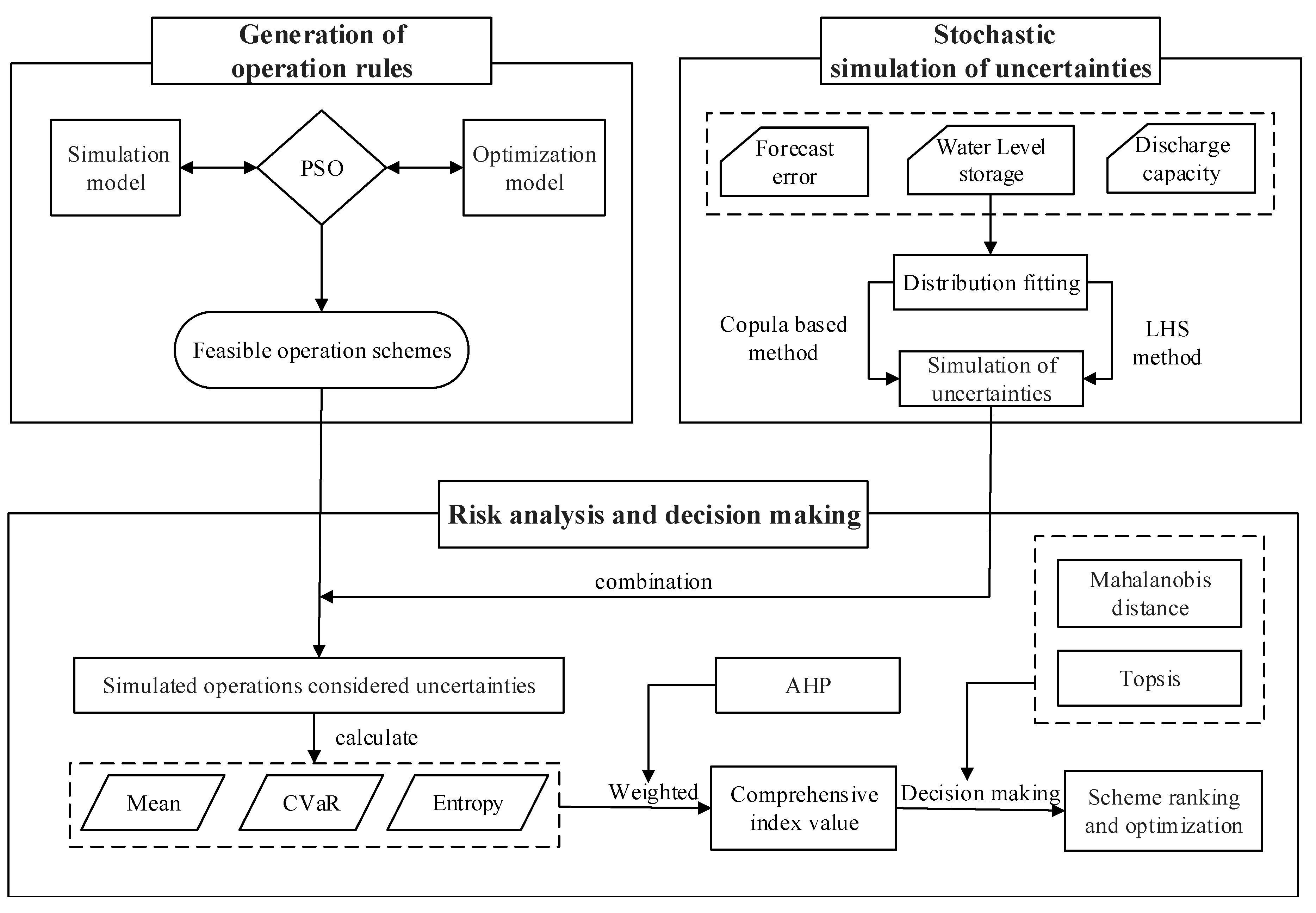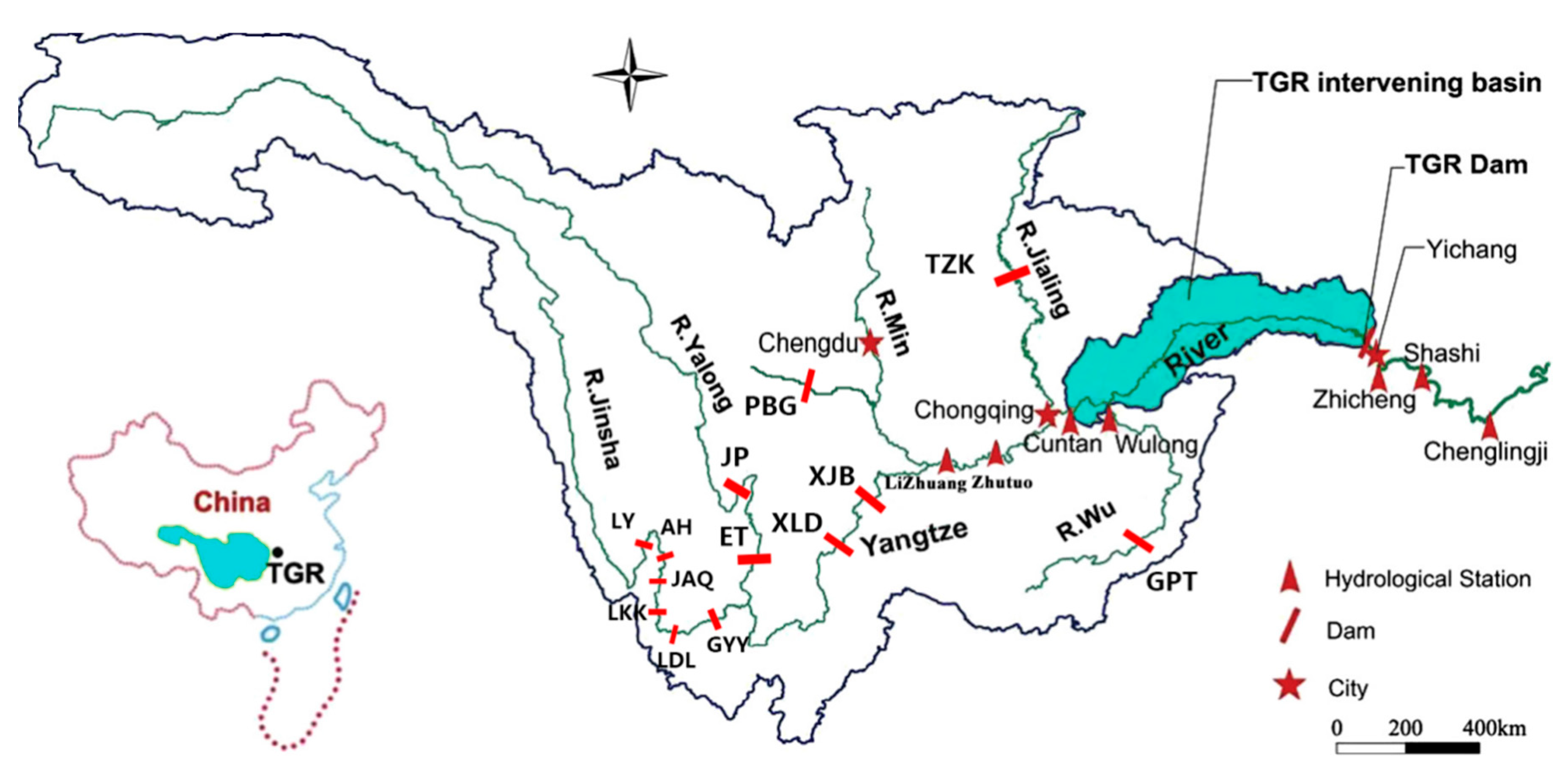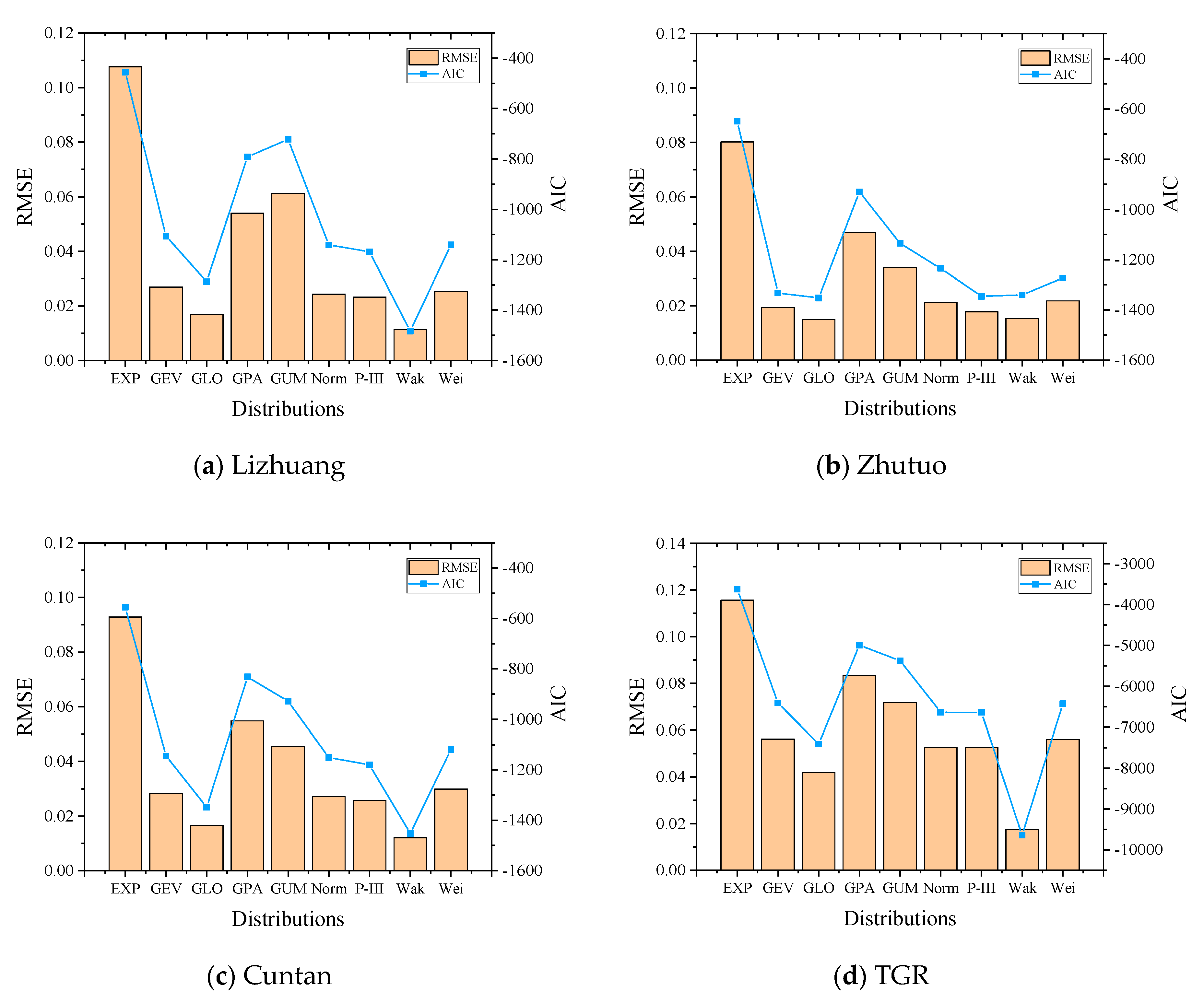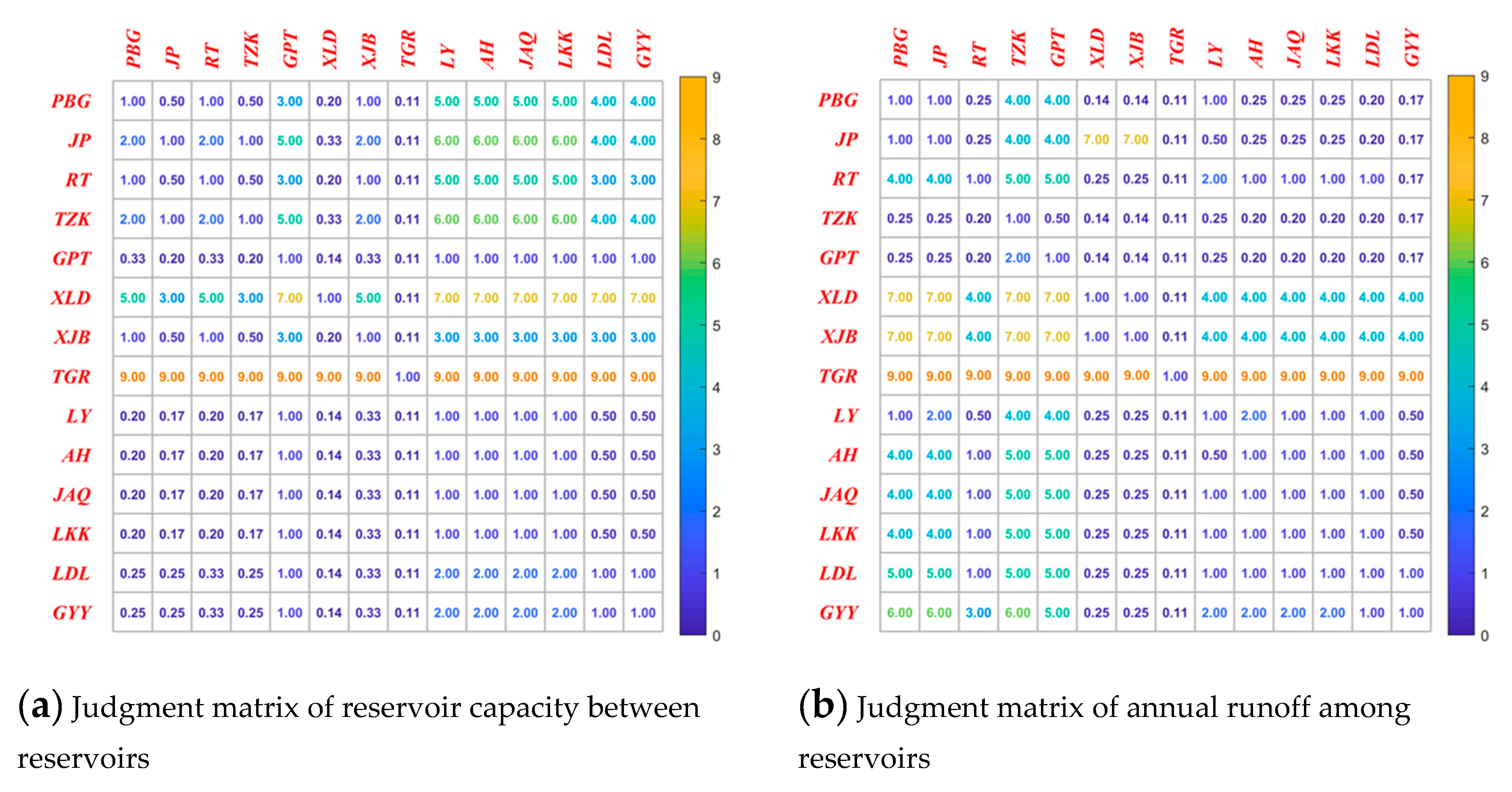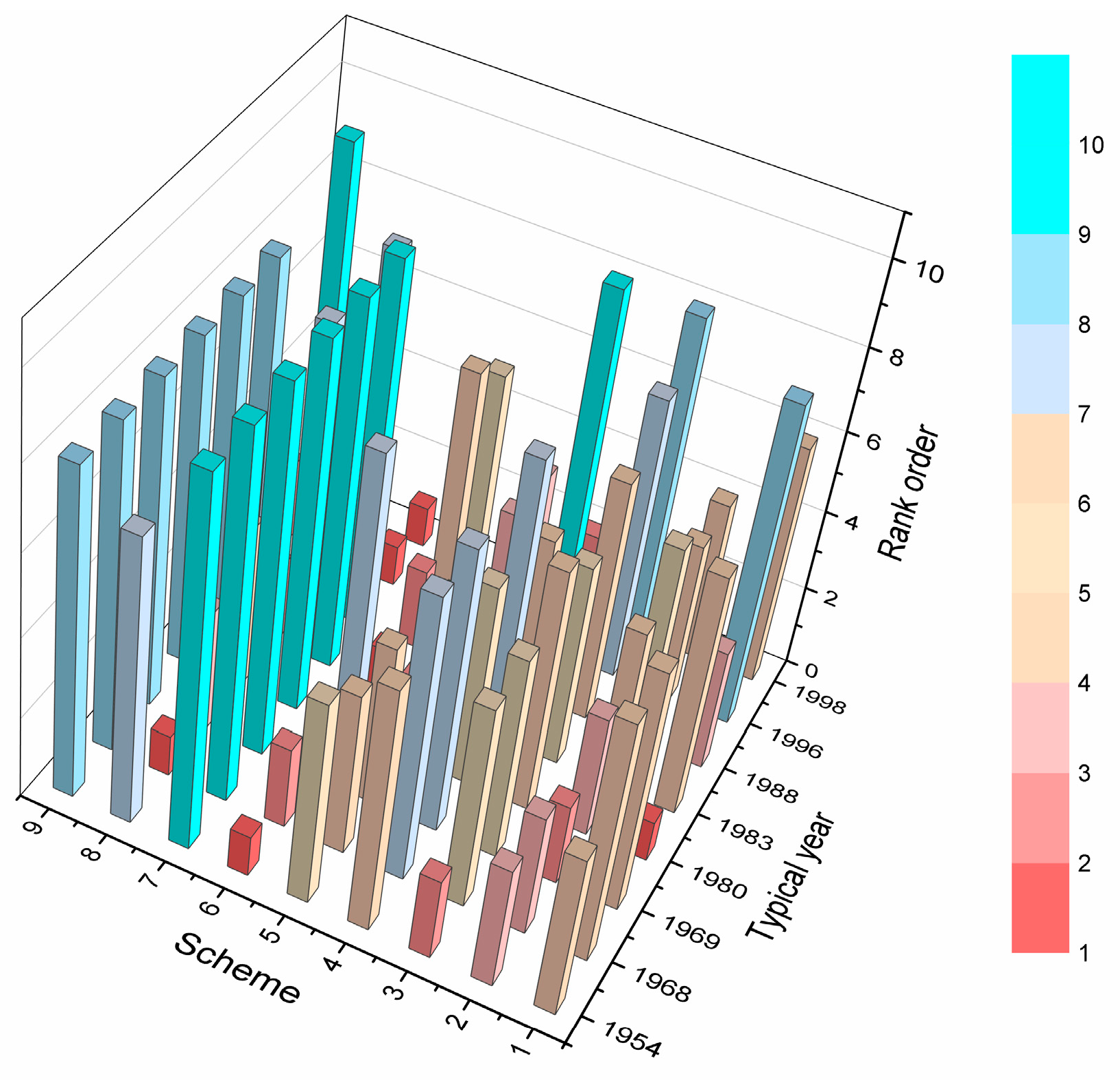1. Introduction
Flood is one of the most damaging natural disasters, which leads to a great loss of life and property [
1]. From 1998 to 2017, floods affected more than 2 billion people worldwide, causing losses of US
$ 656 billion, far more harmful than other disasters [
2]. At present, with the increase of the number of reservoirs built in the basin, multi-reservoir flood control operation has been widely used and has become an important non-project measure to control flood and reduce disasters [
3]. To achieve the full potential of flood control in the multi-reservoir group, judicious multi-reservoir joint operation scheme is needed. Different methods were developed to extract the feasible flood control operation schemes [
4,
5,
6]. However, there are many hydrological and hydraulic uncertain factors in the joint flood control operation, such as flood forecasting errors, water level at flood conditions, outflow discharge capacity, delay time of operation and so on [
7,
8]. These uncertainties will lead to the risk of exceeding the limit of safety water level and discharge volume in the reservoir [
7]. How to quantify the risk of different flood control schemes under the influence of various uncertainties and making decisions to select the optimal scheme is worth to study [
9].
The main uncertainty in flood control operation is the flood forecast uncertainty [
10,
11,
12,
13,
14]. Since the flood forecast provides future streamflow information to guide flood control operation, the uncertainty of flood forecast information may lead to flood control risk. At the same time, the uncertainties in the water level-storage curve and the discharge capacity curve may also influence reservoir flood control operation [
8,
9].
In order to analyze the risk caused by various uncertainties in flood control operation, theoretical research has been carried out and several methods for flood control risk analysis have been developed [
7,
10,
15,
16,
17]. Among them, the Monte-Carlo method, which is widely used in risk assessment of multi-reservoir flood control operation, due to its simple theory and practicability [
18], was widely applied for risk assessment. This method mainly simulates various uncertainties by different mathematical methods, on this basis, simulation scheduling is performed to obtain the possible states of different risk assessment objects (reservoir water level and discharge flow), and the probability of failure was calculated to measure the risk of flood control operation. Li et al. [
15] used a Monte Carlo simulation method to calculate the flood control risk for reservoir operation considering the uncertainties of inflow forecasting error and flood hydrograph shape. Zhang et al. [
19] evaluated the flood overtopping risk from the view of probability theories, synthesized disciplines of reliability math, stochastic hydrology, stochastic hydraulics and so on.
However, the concept of the probability of failure ignores the consequences of extreme situations under the influence of uncertainties. The conditional value at risk (CVaR), which could quantify the losses that might be encountered in the tail, is widely applied to the risk assessment in the flood control system [
20,
21]. Xu et al. [
21] applied the CvaR criterion to reservoir real-time operation under the extremely dry hydrological conditions. At the same time, the discreteness of analog evaluation results after simulation scheduling are equally deserving of attention. The greater the dispersion of the evaluation result, the influence of the uncertainties on the flood control operation is greater, and the corresponding risk is increased. In financial risk assessment, the variance is often used to measure the dispersion of data to characterize the risk [
22]. However, when the probability distribution of risk variable is asymmetrical, it is obviously not enough to measure flood control risk only by variance, the information of higher moments, such as the probability of occurrence of small probability extreme events, cannot be ignored. The information entropy theory proposed by Shannon, as an alternative method, has widely applied to the risk analysis file. For instance, Yang et al. [
23] established a framework for risk analysis on cascade reservoir system using the brittle risk entropy method. Fan et al. [
24] advanced a coupled entropy-copula method for flood peak-duration risk analysis in the Xiangxi River. Huang et al. [
25] evaluated the flood risk, due to different uncertainties in Three Gorges Revision (TGR) during the flood season based on the entropy method.
In this study, the mean value, information entropy and CVaR of risk variable were used to assess flood control risk from multiple perspectives. The three indicators represent the most likely value and the dispersion of risk variable, and the consequence of the extreme situation caused by uncertainties. However, it is necessary to analyze the impact of uncertainties on each reservoir participating in the flood control operation when evaluating the risk of a multi-reservoir joint operation scheme. The analytic hierarchy process (AHP), which is an effective multi-target decision method combing qualitative analysis with quantitative analysis, was employed to determine the weights of each reservoir, the weighted mean value, CvaR and entropy of different flood control schemes were obtained to assess the flood risk from the perspective of the whole basin.
Finally, in order to directly assess the risk of flood control operation, the above risk index values should be converted into a single quantitative value. The technique for order preference by similarity to ideal solution (TOPSIS) method [
26,
27,
28,
29,
30,
31], a multi-criteria decision making method, with the improved Mahalanobis distance, was introduced to evaluate and arrange all schemes combining subjective and objective weights.
The objective of this study is to establish a multi-index risk assessment framework for evaluating the flood risk of multi-reservoir joint flood control operation schemes and decision-making. In this study, a Copula-based method and the Latin hypercube sampling (LHS) method were used to simulate the uncertainties in flood forecast errors, discharge capacity and water level-storage, respectively. The simulated uncertainties series can be used for flood control risk analysis. Combing with the extracted flood control operation schemes, multiple risk indicators were used to assess flood control risk from multiple perspectives. The mean value of a variable was used to represent the possible value of the occurrence of a variable. In order to describe the extreme value of variables, the conditional value at risk (CVaR) was used to evaluate the extreme risk. For the discrete degree of variable distribution, entropy theory was applied to characterize the disorder risk of a variable. Finally, the improved Mahalanobis distance TOPSIS method was used to transform multiple criteria values into a single overall measure with the combination of subjective and objective weights, and then the optimal flood control operation scheme was selected. The proposed methodology is applied to a multi-reservoir flood control operation case study to demonstrate its applicability.
The remainder of this paper is organized as follows:
Section 2 firstly extracts flood control operation schemes of reservoir groups by using the method in
Supplementary Materials, and simulated the uncertainties in reservoir operation. Then, a risk analysis and decision making model for flood control operation are proposed. Finally, describes the data sets used in the study. The results of flood risk analysis using the proposed method are shown in
Section 3. Finally, the conclusions and discussions of this work are presented in
Section 4.
4. Conclusions and Discussions
The main axis of the proposed method is the stochastic simulation of uncertainty, flood control risk assessment and decision making. The proposed method realizes the reasonable optimization selection of flood control operation scheme. The main conclusions of this study are summarized as follows:
- (1)
In this study, a Copula-based method and LHS method were used to simulate the uncertainties in flood forecast errors, discharge capacity and water level-storage which have great influence on flood control operation, respectively. Then, in order to cope with the problem that the traditional reservoir risk assessment index is too single, a multi-index evaluation system with mean, CVaR and entropy was constructed to assess flood control risk from multiple perspectives. In addition, the improved Mahalanobis distance TOPSIS was used to solve the conflict between risk indexes and take into account the risk of each reservoir. The proposed method provides a new way for multi-criteria risk analysis and decision-making of multi-reservoir flood control operation.
- (2)
The proposed method can effectively simulate the uncertainties in flood control operation, and accurately quantify the risk of the subsystems (single reservoir) and the overall risk of the flood control system. For the 100-year design flood hydrograph in 1998, it is obvious that the XLD, XJB and TGR reservoir which undertake larger flood control task, have a greater risk under the influence of uncertainties after calculation with the proposed model. At the same time, different flood control operation schemes have different corresponding risks under the 1998 flood conditions. The optimal scheme is different according to different evaluation indicators. The risk of Scheme 7 is lowest after weighted by subjective and objective weights.
- (3)
The multi-reservoir flood control operation system in the upper reaches of the Yangtze River, which has many flood sources and complicated flood region composition. With this condition, different flood control operation schemes are needed to cope with different reservoir inflow discharge. On the basis of multiple perspective risk analysis, the proposed model can further select an optimal scheme under different design flood hydrographs. For example, among the alternative schemes, the Scheme 7 is optimal when the coming water from the whole basin (1998) and downstream reaches (1996) is large, but this scheme is relatively worse for other typical design floods. Considering all kinds of typical design floods, Scheme 5 and Scheme 6 are relatively optimal.
The proposed method can be applied to many cases of multi-attribute decision making problems in multi-reservoir flood control operation, due to the following advantages. First, the Copula-based method and the LHS method can effectively simulate the related and unrelated uncertainties existed in flood control operation. Second, the proposed method could be used to quantify the partial and overall risk of multi-reservoir flood control operation from multiple perspectives. In this sense, the decision makers will obtain a clear idea of the risk in the multi-reservoir flood control system and can make a decision according to their preferences. Third, this proposed method is based on a Monte-Carlo framework, which eliminates the complicated mathematical derivation and calculation process to describe the complex relationship between uncertainties and risk. Therefore, in real-life applications, the proposed methodology can be easily applied to risk analysis and decision making for multi-reservoir flood control operation under uncertainties.
Furthermore, on the basis of this model, the relationship between uncertainty and risk in reservoir flood control operation could be studied in the future, and the risk transfer mechanism under the influence of uncertainties in flood control operation can be further explored.
